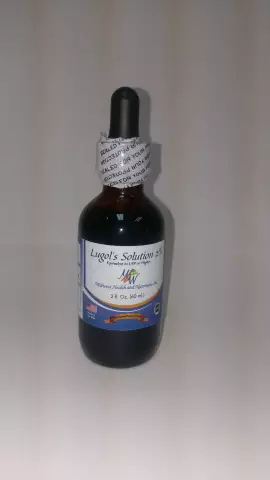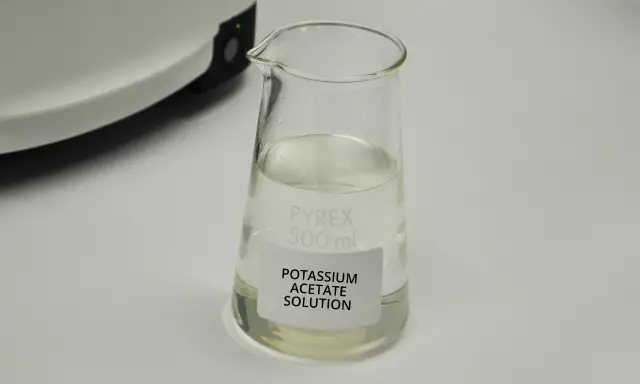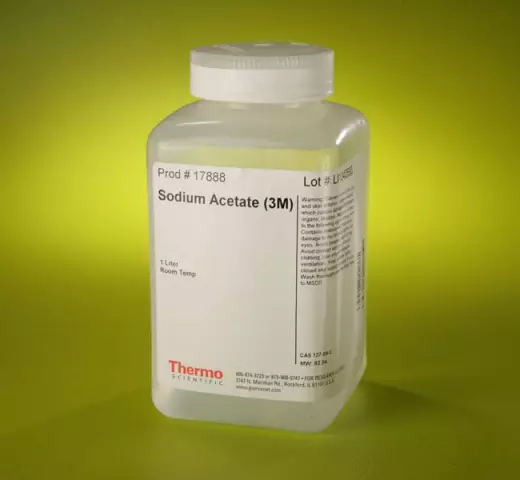- Author Rachel Wainwright [email protected].
- Public 2023-12-15 07:39.
- Last modified 2025-11-02 20:14.
Ditilin
Ditilin: instructions for use and reviews
- 1. Release form and composition
- 2. Pharmacological properties
- 3. Indications for use
- 4. Contraindications
- 5. Method of application and dosage
- 6. Side effects
- 7. Overdose
- 8. Special instructions
- 9. Application during pregnancy and lactation
- 10. Use in childhood
- 11. In case of impaired renal function
- 12. For violations of liver function
- 13. Drug interactions
- 14. Analogs
- 15. Terms and conditions of storage
- 16. Terms of dispensing from pharmacies
- 17. Reviews
- 18. Price in pharmacies
Latin name: Dithylin
ATX code: M03AB01
Active ingredient: Suxamethonium iodide (Suxamethonium iodide)
Producer: Biolek, JSC (Ukraine)
Description and photo update: 2019-18-09

Ditilin is a drug used for short-term muscle relaxation.
Release form and composition
It is produced in the form of a solution for intravenous and intramuscular administration (5 ml in ampoules, in a cardboard box of 5 or 10 ampoules and instructions for use of Ditilin).
The active substance is a part of 1 ml of solution: suxamethonium iodide - 20 mg.
Pharmacological properties
Pharmacodynamics
Suxamethonium iodide is a short-acting depolarizing muscle relaxant. Interacts with H-cholinergic receptors and causes end plate depolarization (blockade of neuromuscular transmission). The process extends to adjacent membranes, with a generalized disorganized contraction of myofibrils (i.e., muscle twitching precede the development of a blockade, which is the result of a short-term facilitation of neuromuscular transmission).
The membranes remain depolarized and do not respond to additional impulses, since to maintain muscle tone, repeated impulses are required, coupled with repolarization of the end plate. The result is spastic paralysis.
Muscle relaxation after intravenous administration of suxamethonium iodide occurs in a specific sequence. First, the muscles of the eyelids, then the chewing muscles, after which other organs and parts of the body are involved in the process - fingers, eyes, limbs, neck, back and stomach, voice communications. The intercostal muscles and the diaphragm complete the sequence.
Suxamethonium iodide leads to increased cerebral blood flow and increased intracranial pressure. The onset of action of the drug is observed in 54-60 seconds after administration, the maximum muscle relaxation develops in 2-3 minutes and lasts for 3 minutes in full. The duration of the action is from 5 to 10 minutes.
The severity of the action of the drug is determined by the value of the administered dose:
- 0.1 mg / ml: relaxation of skeletal muscles is noted, while suxamethonium iodide does not have a significant effect on the respiratory system;
- 0.2-1 mg / kg: complete relaxation of the muscles of the respiratory muscles and the abdominal wall occurs; significant limitation / complete cessation of spontaneous breathing is recorded.
For prolonged muscle relaxation, repeated administration of the solution is required. Controlled and guided muscle relaxation is achieved through a rapid onset of the effect and subsequent rapid recovery of muscle tone.
Pharmacokinetics
After intravenous administration, suxamethonium iodide is distributed in the extracellular fluid and plasma. More than 90% of the substance is hydrolyzed by blood cholinesterase to choline and succinic acid.
The half-life with a normal pseudocholinesterase level is 90 seconds.
Excretion is carried out by the kidneys. It does not penetrate through the intact blood-brain barrier. Does not cumulate.
Indications for use
- Disabling spontaneous breathing (bronchoscopy, intracheal intubation);
- Complete muscle relaxation (reduction of dislocations, endoscopy, reduction of fractures, abdominal, thoracic, gynecological surgical interventions);
- Strychnine poisoning;
- Tetanus (symptomatic treatment);
- Convulsions during electrical impulse therapy (prevention).
Contraindications
- Duchenne muscular dystrophy;
- Hyperkalemia;
- Malignant hyperthermia (including history);
- Bronchial asthma;
- Myotonia (congenital and dystrophic);
- Myasthenia gravis;
- Acute liver failure;
- Closed-angle glaucoma;
- Penetrating eye injuries;
- Pulmonary edema;
- Age up to 1 year;
- Pregnancy and lactation (breastfeeding);
- Hypersensitivity to drug components.
Ditilin should be used with caution in the following diseases / conditions:
- Decrease in serum pseudocholinesterase activity (anemia, hepatic failure in the terminal stage, widespread burns, cachexia, chronic infections, prolonged starvation, trauma);
- Chronic renal failure
- Condition after plasma transfusion;
- Postpartum period;
- Plasmapheresis;
- Tuberculosis;
- Tetanus;
- Artificial blood circulation;
- Malignant neoplasms;
- Systemic connective tissue diseases;
- Myxedema;
- Emergency surgery in patients with a "full stomach";
- Chronic and acute intoxication with insecticides - cholinesterase inhibitors (if ingested) or anticholinesterase agents (physostigmine, neostigmine, distigmine bromide);
- Simultaneous use with drugs competing with succinylcholine for cholinesterase (intravenous procaine).
Ditilin, instructions for use: method and dosage
For adults, Ditilin solution is injected intravenously slowly, drip or stream (for continuous drip infusion, a 0.1% solution is used). Depending on the clinical situation, with intravenous administration, a single dose can vary from 0.1 to 1.5-2 mg / kg of body weight.
During tracheal intubation, 0.2-0.8 mg / kg is administered; for the prevention of complications during electrical impulse treatment (tearing of tendons and muscles, convulsions) - 0.1-1 mg / kg intravenously (up to 150 mg); to turn off spontaneous breathing and muscle relaxation - 0.2-1 mg / kg; during endoscopy - 0.2 mg / kg; for relaxation of skeletal muscles when comparing bone fragments after fractures and repositioning dislocations - 0.1-0.2 mg / kg.
For prolonged relaxation of the muscles throughout the operation, Ditilin can be used fractionally: 0.5-1 mg / kg with a break of 5-7 minutes. As a rule, the administration of repeated doses promotes a longer duration of action.
For children, Ditilin solution is administered intravenously at 1-2 mg / kg or intramuscularly at doses up to 2.5 mg / kg (maximum 150 mg).
Side effects
During the use of the drug, the development of allergic reactions (bronchospasm, anaphylactic shock) and hyperkalemia can be observed.
Also, with the introduction of Ditilin, the following side effects may occur: lowering blood pressure, arrhythmia, impaired cardiac conduction, bradycardia (more often in children, with repeated use in adults and children), fever, cardiogenic shock, hypersalivation, increased intraocular pressure, myalgia (in postoperative period), prolonged paralysis of the respiratory muscles. In rare cases, rhabdomyolysis may occur with the development of myoglobinuria and myoglobinemia.
Children, women and young patients (mainly vagotonics) may experience short-term bradycardia, in some cases - asystole.
After 10-12 hours after the administration of Ditilin, muscle pain may develop.
With repeated use of the drug, prolonged apnea and excessively prolonged muscle relaxation are sometimes observed.
Overdose
The main symptoms: increased severity of side effects, respiratory arrest.
Therapy: artificial lung ventilation; with a decrease in the content of cholinesterase in the blood serum, transfusion of fresh blood is indicated.
special instructions
Ditilin is used only in specialized departments with equipment for artificial ventilation of the lungs during general anesthesia.
Fibrillar muscle twitching and the subsequent development of muscle pain can be avoided by preliminary administration of diplacin chloride at a dose of 10-15 mg or tubocurarine chloride at a dose of 3-4 mg before the infusion of Ditilin (within 1 minute).
Slow administration of Ditilin, as well as preliminary intravenous injection of 1-1.5 mg of atropine, largely prevent the development of bradycardia and increased bronchial secretion.
Patients with renal insufficiency (without signs of neuropathy and hyperkalemia) Ditilin should be administered once in medium doses. The drug is not recommended for use in high doses or for repeated administrations (due to the risk of hyperkalemia).
Prolonged muscle relaxation with the possible development of apnea can be observed due to several reasons: hereditary insufficiency of serum cholinesterase or a temporary decrease in its level, "atypical" serum cholinesterase.
Application during pregnancy and lactation
Ditilin is not prescribed during pregnancy / lactation.
Pediatric use
For patients under 1 year of age, the drug is contraindicated.
With impaired renal function
In chronic renal failure, Ditilin is prescribed with caution.
For violations of liver function
- Acute liver failure: therapy is contraindicated;
- Decreased activity of serum pseudocholinesterase (in patients with end-stage liver failure): the drug is used with caution.
Drug interactions
With the simultaneous use of Ditilin with certain drugs, undesirable effects may occur:
- Verapamil, amphotericin B, anticholinesterase agents, procainamide, procaine, clindamycin, lidocaine, beta-blockers, aminoglycoside antibiotics, cyclopropane, quinidine, organophosphate insecticides, propanidide, magnesium and lithium salts, chloroquine, drugs blood cholinesterase (diphenhydramine, aprotinin, estrogens, promegazine, oxytocin, oral contraceptives, glucocorticosteroids in high doses): lengthening and increasing the muscle relaxant effect of Ditilin;
- Cardiac glycosides: increased cardiac effects;
- Anti-myasthenic drugs: decrease in their effectiveness;
- Halogenated agents for general anesthesia: increasing undesirable effects on the cardiovascular system;
- Atropine and sodium thiopental: reducing undesirable effects on the cardiovascular system.
The drug is compatible with other muscle relaxants, narcotic analgesics, Ringer's solution, 6% dextran solution, isotonic sodium chloride solutions and 5% fructose solution.
Ditilin is pharmaceutically incompatible with alkaline solutions and barbiturate solutions (due to sediment formation), as well as with blood products and donated blood (due to hydrolysis).
Analogs
The analogs of Ditilin are: Ditilin-Darnitsa, Suxamethonium iodide, Suxamethonium chloride, Suxamethonium bromide, Suxamethonium-Biolek, Listenon.
Terms and conditions of storage
Store in a dark place, out of reach of children, at a temperature of 2-8 ° C.
The shelf life is 1.5 years.
Terms of dispensing from pharmacies
Dispensed by prescription.
Reviews about Ditilin
Reviews of Ditilin are few, since the drug is used during general anesthesia or in emergency therapy, often simultaneously with other drugs.
Price for Ditilin in pharmacies
The approximate price of Ditilin, a solution for intravenous and intramuscular administration of 20 mg / ml, for 5 ampoules in a package is 55 rubles.

Anna Kozlova Medical journalist About the author
Education: Rostov State Medical University, specialty "General Medicine".
Information about the drug is generalized, provided for informational purposes only and does not replace the official instructions. Self-medication is hazardous to health!






